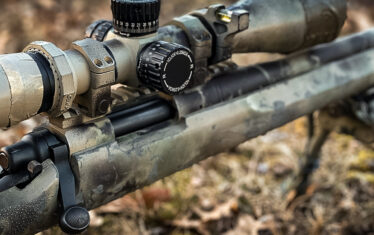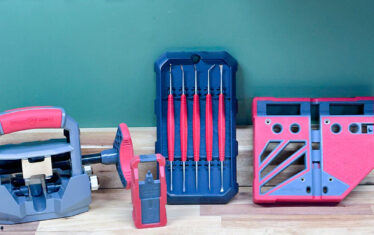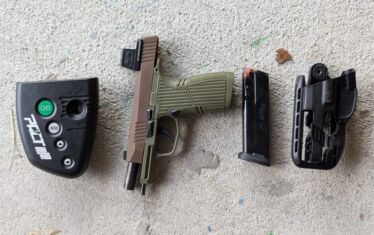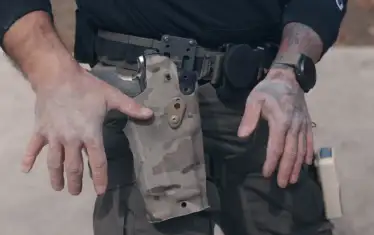The Smith & Wesson Model 686 revolver needs little introduction. First introduced in 1981, the 686 was the answer to the demands of law enforcement personnel who needed a revolver that could handle the higher pressures of the .357 Magnum full time while being light enough to carry.
The 686 is an all-stainless steel six-shot double-action revolver that is based on the classic K-frame design, save for a taller cylinder frame, beefier forcing cone, and under-lugged barrel. This was the first L-frame-sized revolver, a size perfect for .357 Magnum and large enough for stouter caliber revolvers like the five-shot .44 Magnum Model 69.
In the 1990s, Smith & Wesson debuted the 686+, a seven-shot version of the previous design. The Plus model is, by far, the most common version Smith & Wesson now makes. It comes in a variety of barrel lengths as long as seven inches.
I have long been a fan of the classic 3-inch and 4-inch models, but I recently acquired the most diminutive model: the 686+ with a 2.5-inch barrel. Although there is a certain amount of diminishing returns when you shrink down a Magnum revolver and give it less barrel, this revolver is likely among the best-shooting concealed carry revolvers you can find.
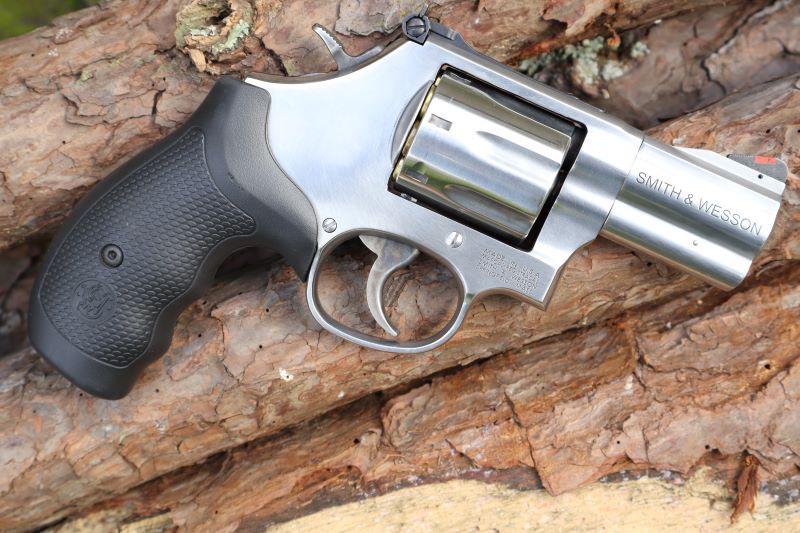
Features
Although the barrel has been lopped to 2.5 inches in length, the 686+ snub nose is still the same substantial stainless-steel sidearm everywhere else. It has a round butt if you choose to mount some low-profile K-frame grips, but it ships from the factory with a pair of wrap-around Hogue rubber grips.
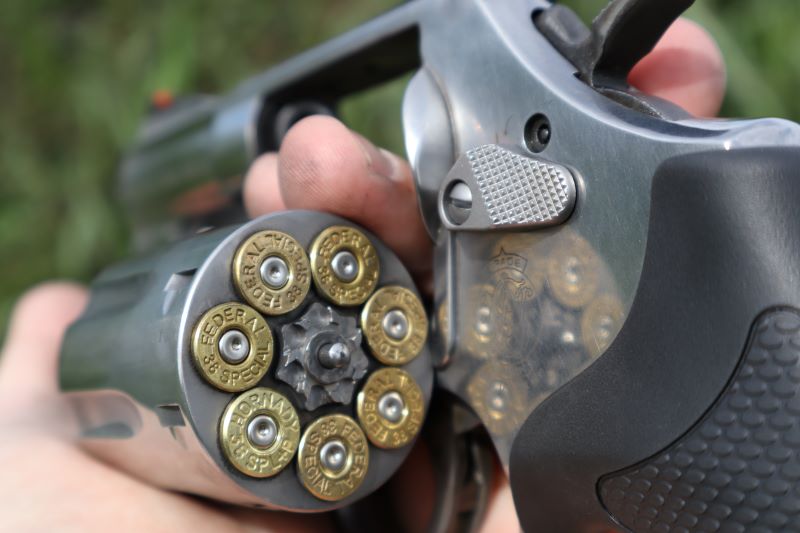
Like other stock 686+ models, it has a push-forward cylinder release and a fully underlugged barrel. The snubbie 2.5-inch model uses the same pinned red-ramped front sight and a rear notch that is adjustable for windage and elevation as the longer barreled models. It is a double-action/single-action revolver with an exposed hammer that can be cocked for a lighter trigger pull or fired by a long pull of the trigger.
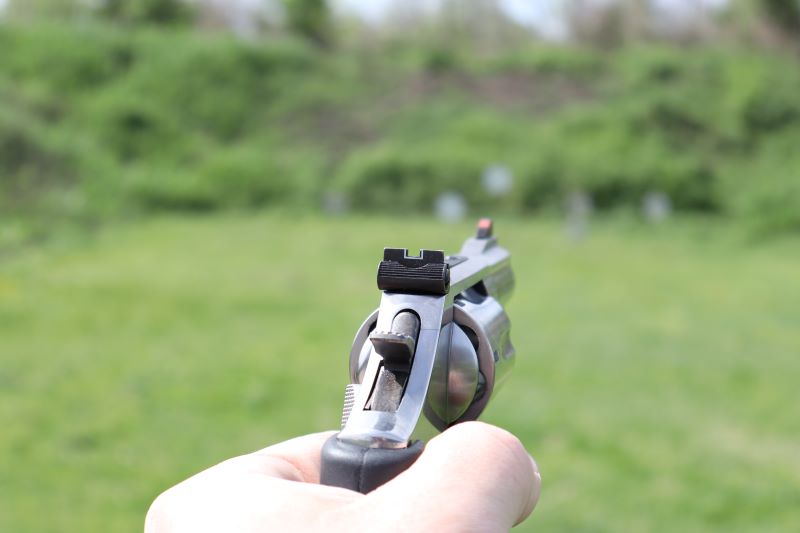
The 686+ 2.5-inch model has a seven-shot capacity. The only substantial difference from other models is its use of a shorter ejector rod to compliment the shorter barrel. It chambers the .357 Magnum cartridge but the revolver will happily shoot the shorter but otherwise dimensionally identical .38 Special round.
Quick Specs
- Model: 686+
- Barrel Length: 2.5 inches
- Overall Length: 7.5 inches
- Height: 5.75 inches (with stock grips)
- Width: 1.55 inches
- Weight: 38 ounces (loaded)
Operation
The 686+ loads, unloads, and operates like most double-action revolvers. Pushing forward on the cylinder release allows you to roll the cylinder out to the left side. You can then drop in your ammunition one round at a time. You might also make use of Bianchi Speed Strips or a seven-shot speedloader to hurry the loading process. The cylinder is then shut.
To shoot, all you have to do is line up the sights and press the trigger rearward. The double-action trigger pull cocks the hammer and releases it. The 686+, unlike the smaller J-frame style revolvers, uses a leaf mainspring, which equates to a smooth trigger pull with no stacking. On my Lyman trigger scale, the trigger breaks at 7 lbs. 9 oz.
Alternatively, the 686+ has a hefty, exposed hammer that you can thumb back to shorten the trigger pull. This single-action trigger pull comes in at just over three pounds, which is more than light enough to get accustomed to shooting before progressing to quicker double-action shooting.
Unloading the revolver is just as easy as loading. All you have to do is roll out the cylinder again and press the ejector rod to kick the empty cases free. The 686+ has a shorter ejector rod compared to the travel the empty cases need to go to clear the cylinder.
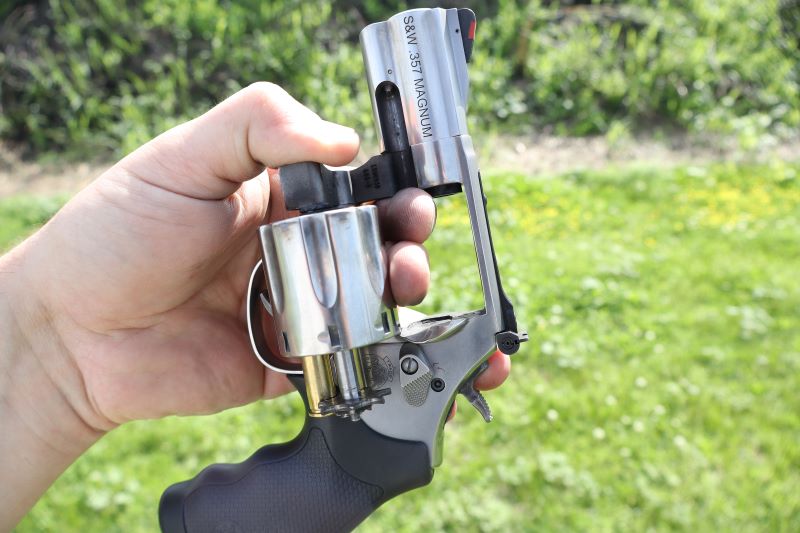
With some Magnum ammunition, you might have to give the rod a sharp smack to make sure those cases eject. This was the case with some Remington 125 grain HTP and Buffalo Bore 158 grain .357 Magnum rounds, but with moderate magnums and .38 Special rounds, the cases come out with thumb pressure.
Shooting the 686+ Snubbie
The Model 686 is a design known for its accuracy and reliability. Revolvers are fixed barrel designs and generally eliminate malfunctions inadvertently caused by you.
Reliability
My run with the 686+ snub nose was not perfect, but after 300 rounds of mostly .357 Magnum ammo and some .38 Special loads thrown in, I had no failures to fire or eject.
Late in that round count, I began to encounter trouble freeing the cylinder from the revolver and discovered the ejector rod had come partially unscrewed. Revolvers are machines that are screwed together and making sure those screws are locked down is part of periodic maintenance, the ejector rod being one aspect of that.
Accuracy
Shorter-barreled guns are often criticized for being less accurate than their longer-barreled counterparts.
While the sighting radius between the iron sights is diminished compared to its bigger brothers, the snubbie 686+ comes with the same target-style sights as those revolvers. Compared to the fixed and low profile sights of typical snubnosed revolvers, these pop out and are easy to find and put on target. The smooth double-action trigger pull and the option for single-action makes the picture even better.
Thanks to its .357 Magnum chambering, you also have the option to use lighter-recoiling .38 Special ammo.
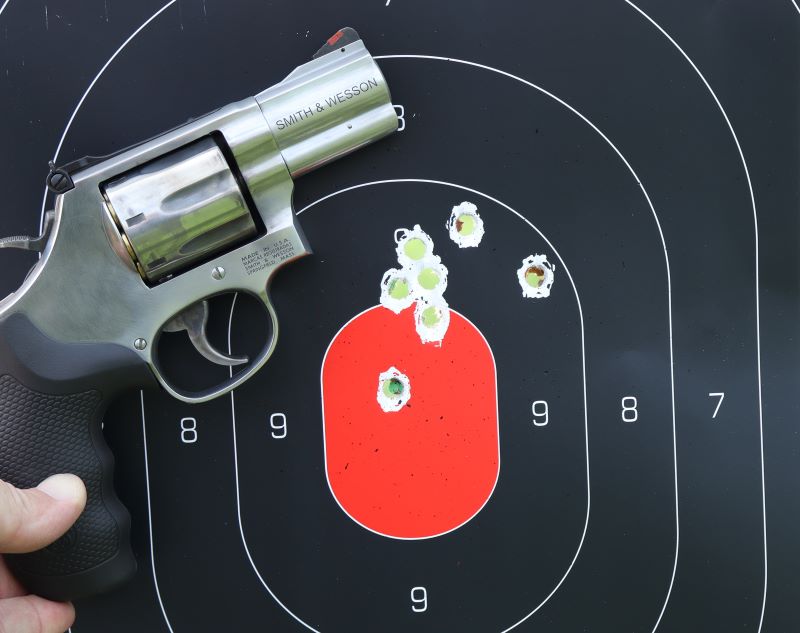
The .38 is an inherently accurate round and its shooting characteristics make it hard to pick up bad habits.
Recoil out of the all-steel 686+ with my .38 Special wadcutter handloads was light. Other standard pressure .38 Special loads hardly disturbed the sights. Recoil and blast were more pronounced but manageable with .38 Special +P and light Magnums like the Ammo Inc. 158 grain TMJ and Federal 158 grain JSP rounds that comprised most of the rounds I fired.
I also shot a box of Federal 158 grain Hydrashocks, as well as the legendary Remington 125 grain semi-jacketed hollowpoint and the Buffalo Bore 158 grain XTP rounds. Recoil was more prohibitive with the latter rounds. The revolver twisted around more in my hand, and it proved harder to get follow-up shots until I gripped the revolver with more determination. From then on, my shot times improved.
All ammunition shot close to the same group sizes when I put the 686+ on paper at seven and 15 yards. But the difference in recoil made more of a difference when shooting at my eight-inch steel plates from distances of seven to 50 yards. I could generally lob the .38 Special rounds into the plates at any distance quickly and easily, which can’t be said for most snubnose revolvers. The .357s could do the same but it required more concentration.
In terms of power, the 686+ 2.5 inch might be disadvantageous compared to longer-barreled guns, but that does not make the Magnum snubbie mute. The Remington and Buffalo Bore ammunitions shot across my chronograph at over 1,300 feet per second. The 686+, even with this shorter barrel, can run ammunition as lightly recoiling as a .22 rimfire to ammunition that spanks most other handgun rounds.
Aftermarket Options for the S&W 686+
Although it is not as prolific as the small-frame five-shot Smith & Wesson J-frame, the 686+ snubbie has some history and an aftermarket to back it up.
Spare parts are a click away while some accessories are as close as the nearest retailer. Speedloaders and speedstrips for quick reloading are readily available, although you have to make sure you are purchasing loaders for the seven-shot revolver, not the six-shot.
That caveat extends to holsters. There are a number of Kydex and leather options out there. While I found it possible to tot the 686+ snubbie IWB, its wider cylinder is easier to squeeze against your side when carrying outside the waistband. The Bianchi Thumbsnap Suede OWB holster is perfect for that application.
The only modification I would make to my 686+ would be new grips. The Hogue grips that come from the factory are hand-filling but somewhat big for concealed carry. Thankfully, the 686+ will take any number of round-butt K-frame grips, and this one is begging for a pair of Altamont boot grips.
The Smith & Wesson 686+: The Shootable Snubbie
I initially acquired my Smith & Wesson 686+ snub nose because I was interested in how short of a barrel one could get with a Magnum revolver but still be effective. While the chronograph tells me that some .357 Magnum ammo can still be quite effective, even out of this short barrel, my shooting experience thus far had me thinking on an alternative theme — the shootable snubbie.
Most snubnosed revolvers like the aforementioned J-frame, the Ruger LCR, and the Taurus 856 make sacrifices to become lightweight and easy to carry. Most snubbies are five-shooters and come with any mix of aluminum, scandium, and even polymer frames to cut down on the weight and size. The sights leave something to be desired, as does the trigger. Recoil can be obnoxious and accuracy a mixed bag.
The 686+ with a 2.5-inch barrel is essentially an oversized snub nose. It is a heavy all-steel revolver that is harder to carry but easier to control. It also brings better sights, a better trigger, and two extra rounds to the firing line.
While not a true master of Magnum power or a natural for concealed carry, the 686+ is an excellent choice for those who want a handgun that is capable of both.






